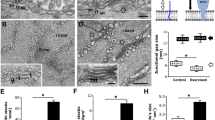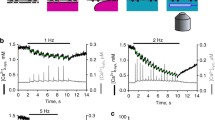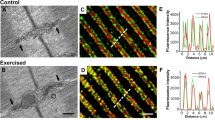Abstract
Store-operated Ca2+ entry (SOCE) has been found to be a rapidly activated robust mechanism in skeletal muscle fibres. It is conducted across the junctional membranes by stromal interacting molecule 1 (STIM1) and Orai1, which are housed in the sarcoplasmic reticulum (SR) and tubular (t-) system, respectively. These molecules that conduct SOCE appear evenly distributed throughout the SR and t-system of skeletal muscle, allowing for rapid and local control in response to depletions of Ca2+ from SR. The significant depletion of SR Ca2+ required to reach the activation threshold for SOCE could only be achieved during prolonged bouts of excitation–contraction coupling (EC coupling) in a healthy skeletal muscle fibre, meaning that this mechanism is not responsible for refilling the SR with Ca2+ during periods of fibre quiescence. While Ca2+ in SR remains below the activation threshold for SOCE, a low-amplitude persistent Ca2+ influx is provided to the junctional cleft. This article reviews the properties of SOCE in skeletal muscle and the proposed molecular mechanism, assesses its potential physiological roles during EC coupling, namely refilling the SR with Ca2+ and simple balancing of Ca2+ within the cell, and also proposes the possibility of SOCE as a potential regulator of t-system and SR membrane protein function.






Similar content being viewed by others
Abbreviations
- SR:
-
Sarcoplasmic reticulum
- SOCE:
-
Store-operated Ca2+ entry
- t-system:
-
Tubular system
- EC coupling:
-
Excitation–contraction coupling
- ER:
-
Endoplasmic reticulum
- CSQ:
-
Calsequestrin
- DHPR:
-
Dihydropyridine receptor
- RyR:
-
Ryanodine receptor
- STIM:
-
Stromal interacting molecule
- TnC:
-
Troponin C
References
Allard B, Couchoux H, Pouvreau S, Jacquemond V (2006) Sarcoplasmic reticulum Ca2+ release and depletion fail to affect sarcolemmal ion channel activity in mouse skeletal muscle. J Physiol 575:69–81
Allen DG, Lamb GD, Westerblad H (2008) Impaired calcium release during fatigue. J Appl Physiol 104:296–305
Allen DG, Lamb GD, Westerblad H (2008) Skeletal muscle fatigue: cellular mechanisms. Physiol Rev 88:287–332
Almers W, Fink R, Palade PT (1981) Calcium depletion in frog muscle tubules: the decline of calcium current under maintained depolarization. J Physiol 312:177–207
Arruda AP, Oliveira GM, Carvalho DP, De Meis L (2005) Thyroid hormones differentially regulate the distribution of rabbit skeletal muscle Ca2+-ATPase (SERCA) isoforms in light and heavy sarcoplasmic reticulum. Mol Membr Biol 22:529–537
Baylor SM, Hollingworth S (2003) Sarcoplasmic reticulum calcium release compared in slow-twitch and fast-twitch fibres of mouse muscle. J Physiol 551:125–138
Beard NA, Wei L, Dulhunty AF (2009) Ca2+ signaling in striated muscle: the elusive roles of triadin, junctin, and calsequestrin. Eur Biophys J 39:27–36
Berbey C, Allard B (2009) Electrically silent divalent cation entries in resting and active voltage-controlled muscle fibers. Biophys J 96:2648–2657
Bianchi CP, Shanes AM (1959) Calcium influx in skeletal muscle at rest, during activity, and during potassium contracture. J Gen Physiol 42:803–815
Bolanos P, Guillen A, DiPolo R, Caputo C (2009) Factors affecting SOCE activation in mammalian skeletal muscle fibers. J Physiol Sci 59:317–328
Brum G, Fitts R, Pizarro G, Rios E (1988) Voltage sensors of the frog skeletal muscle membrane require calcium to function in excitation–contraction coupling. J Physiol 398:475–505
Brum G, Rios E, Stefani E (1988) Effects of extracellular calcium on calcium movements of excitation–contraction coupling in frog skeletal muscle fibres. J Physiol 398:441–473
Cahalan MD (2009) STIMulating store-operated Ca2+ entry. Nat Cell Biol 11:669–677
Collet C, Ma J (2004) Calcium-dependent facilitation and graded deactivation of store-operated calcium entry in fetal skeletal muscle. Biophys J 87:268–275
Curtis BA (1966) Ca fluxes in single twitch muscle fibers. J Gen Physiol 50:255–267
Curtis BA, Eisenberg RS (1985) Calcium influx in contracting and paralyzed frog twitch muscle fibers. J Gen Physiol 85:383–408
Dirksen RT (2009) Checking your SOCCs and feet: the molecular mechanisms of Ca2+ entry in skeletal muscle. J Physiol 587:3139–3147
Ducret T, Vandebrouck C, Cao ML, Lebacq J, Gailly P (2006) Functional role of store-operated and stretch-activated channels in murine adult skeletal muscle fibres. J Physiol 575:913–924
Duke AM, Steele DS (2008) The presence of a functional t-tubule network increases the sensitivity of RyR1 to agonists in skinned rat skeletal muscle fibres. Cell Calcium 44:411–421
Edwards JN, Friedrich O, Cully TR, von Wegner F, Murphy RM, Launikonis BS (2010) Upregulation of store-operated Ca2+ entry in dystrophic mdx mouse muscle. Am J Physiol Cell Physiol 299:C42–C50
Edwards JN, Launikonis BS (2008) The accessibility and interconnectivity of the tubular system network in toad skeletal muscle. J Physiol 586:5077–5089
Edwards JN, Murphy RM, Cully TR, von Wegner F, Friedrich O, Launikonis BS (2010) Ultra-rapid activation and deactivation of store-operated Ca2+ entry in skeletal muscle. Cell Calcium 47:458–467
Franzini-Armstrong C (2009) Architecture and regulation of the Ca2+ delivery system in muscle cells. Appl Physiol Nutr Metab 34:323–327
Fryer MW, Owen VJ, Lamb GD, Stephenson DG (1995) Effects of creatine phosphate and Pi on Ca2+ movements and tension development in rat skinned skeletal muscle fibres. J Physiol 482:123–140
Fryer MW, Stephenson DG (1996) Total and sarcoplasmic reticulum calcium contents of skinned fibres from rat skeletal muscle. J Physiol 493:357–370
Gissel H, Clausen T (1999) Excitation-induced Ca2+ uptake in rat skeletal muscle. Am J Physiol 276:R331–R339
Gonzalez Narvaez AA, Castillo A (2007) Ca2+ store determines gating of store operated calcium entry in mammalian skeletal muscle. J Muscle Res Cell Motil 28:105–113
Gwack Y, Srikanth S, Feske S, Cruz-Guilloty F, Oh-hora M, Neems DS, Hogan PG, Rao A (2007) Biochemical and functional characterization of Orai proteins. J Biol Chem 282:16232–16243
Ikemoto N, Antoniu B, Kang JJ, Meszaros LG, Ronjat M (1991) Intravesicular calcium transient during calcium release from sarcoplasmic reticulum. Biochemistry 30:5230–5237
Kurebayashi N, Ogawa Y (2001) Depletion of Ca2+ in the sarcoplasmic reticulum stimulates Ca2+ entry into mouse skeletal muscle fibres. J Physiol 533:185–199
Lamb GD, Junankar PR, Stephenson DG (1995) Raised intracellular [Ca2+] abolishes excitation–contraction coupling in skeletal muscle fibres of rat and toad. J Physiol 489:349–362
Lamb GD, Stephenson DG (1991) Effect of Mg2+ on the control of Ca2+ release in skeletal muscle fibres of the toad. J Physiol 434:507–528
Launikonis BS, Barnes M, Stephenson DG (2003) Identification of the coupling between skeletal muscle store-operated Ca2+ entry and the inositol trisphosphate receptor. Proc Natl Acad Sci USA 100:2941–2944
Launikonis BS, Brum G, Rios E, Zhou J (2005) How the calcium-precipitating anions inorganic phosphate and SO 2−4 alter intra-SR calcium in skeletal muscle cells. Biophys J 88:89a
Launikonis BS, Rios E (2007) Store-operated Ca2+ entry during intracellular Ca2+ release in mammalian skeletal muscle. J Physiol 583:81–97
Launikonis BS, Stephenson DG, Friedrich O (2009) Rapid Ca2+ flux through the transverse tubular membrane, activated by individual action potentials in mammalian skeletal muscle. J Physiol 587:2299–2312
Launikonis BS, Zhou J, Royer L, Shannon TR, Brum G, Rios E (2006) Depletion "skraps" and dynamic buffering inside the cellular calcium store. Proc Natl Acad Sci USA 103:2982–2987
Laver DR, O'Neill ER, Lamb GD (2004) Luminal Ca2+-regulated Mg2+ inhibition of skeletal RyRs reconstituted as isolated channels or coupled clusters. J Gen Physiol 124:741–758
Lee KP, Yuan JP, Zeng W, So I, Worley PF, Muallem S (2009) Molecular determinants of fast Ca2+-dependent inactivation and gating of the Orai channels. Proc Natl Acad Sci USA 106:14687–14692
Lewis RS (2007) The molecular choreography of a store-operated calcium channel. Nature 446:284–287
Luik RM, Wang B, Prakriya M, Wu MM, Lewis RS (2008) Oligomerization of STIM1 couples ER calcium depletion to CRAC channel activation. Nature 454:538–542
Luik RM, Wu MM, Buchanan J, Lewis RS (2006) The elementary unit of store-operated Ca2+ entry: local activation of CRAC channels by STIM1 at ER-plasma membrane junctions. J Cell Biol 174:815–825
Lyfenko AD, Dirksen RT (2008) Differential dependence of store-operated and excitation-coupled Ca2+ entry in skeletal muscle on STIM1 and Orai1. J Physiol 586:4815–4824
Lyfenko AD, Dirksen RT (2010) Molecular mechanism of store-operated Ca2+ entry in adult mammalian skeletal muscle. Biophys J 98:202a
McCarl CA, Picard C, Khalil S, Kawasaki T, Rother J, Papolos A, Kutok J, Hivroz C, Ledeist F, Plogmann K, Ehl S, Notheis G, Albert MH, Belohradsky BH, Kirschner J, Rao A, Fischer A, Feske S (2009) ORAI1 deficiency and lack of store-operated Ca2+ entry cause immunodeficiency, myopathy, and ectodermal dysplasia. J Allergy Clin Immunol 124(1311–1318):e1317
Melzer W, Herrmann-Frank A, Luttgau HC (1995) The role of Ca2+ ions in excitation–contraction coupling of skeletal muscle fibres. Biochim Biophys Acta 1241:59–116
Mullins FM, Park CY, Dolmetsch RE, Lewis RS (2009) STIM1 and calmodulin interact with Orai1 to induce Ca2+-dependent inactivation of CRAC channels. Proc Natl Acad Sci USA 106:15495–15500
Murphy RM, Larkins NT, Mollica JP, Beard NA, Lamb GD (2009) Calsequestrin content and SERCA determine normal and maximal Ca2+ storage levels in sarcoplasmic reticulum of fast- and slow-twitch fibres of rat. J Physiol 587:443–460
Ng SW, di Capite J, Singaravelu K, Parekh AB (2008) Sustained activation of the tyrosine kinase Syk by antigen in mast cells requires local Ca2+ influx through Ca2+ release-activated Ca2+ channels. J Biol Chem 283:31348–31355
Parekh AB (2008) Ca2+ microdomains near plasma membrane Ca2+ channels: impact on cell function. J Physiol 586:3043–3054
Parekh AB, Putney JW Jr (2005) Store-operated calcium channels. Physiol Rev 85:757–810
Park CY, Hoover PJ, Mullins FM, Bachhawat P, Covington ED, Raunser S, Walz T, Garcia KC, Dolmetsch RE, Lewis RS (2009) STIM1 clusters and activates CRAC channels via direct binding of a cytosolic domain to Orai1. Cell 136:876–890
Park H, Park IY, Kim E, Youn B, Fields K, Dunker AK, Kang C (2004) Comparing skeletal and cardiac calsequestrin structures and their calcium binding: a proposed mechanism for coupled calcium binding and protein polymerization. J Biol Chem 279:18026–18033
Penna A, Demuro A, Yeromin AV, Zhang SL, Safrina O, Parker I, Cahalan MD (2008) The CRAC channel consists of a tetramer formed by Stim-induced dimerization of Orai dimers. Nature 456:116–120
Posterino GS, Lamb GD (2003) Effect of sarcoplasmic reticulum Ca2+ content on action potential-induced Ca2+ release in rat skeletal muscle fibres. J Physiol 551:219–237
Posterino GS, Lamb GD, Stephenson DG (2000) Twitch and tetanic force responses and longitudinal propagation of action potentials in skinned skeletal muscle fibres of the rat. J Physiol 527:131–137
Rome LC (2006) Design and function of superfast muscles: new insights into the physiology of skeletal muscle. Annu Rev Physiol 68:193–221
Royer L, Rios E (2009) Deconstructing calsequestrin. Complex buffering in the calcium store of skeletal muscle. J Physiol 587:3101–3111
Stiber J, Hawkins A, Zhang ZS, Wang S, Burch J, Graham V, Ward CC, Seth M, Finch E, Malouf N, Williams RS, Eu JP, Rosenberg P (2008) STIM1 signalling controls store-operated calcium entry required for development and contractile function in skeletal muscle. Nat Cell Biol 10:688–697
Vandebrouck C, Martin D, Colson-Van Schoor M, Debaix H, Gailly P (2002) Involvement of TRPC in the abnormal calcium influx observed in dystrophic (mdx) mouse skeletal muscle fibers. J Cell Biol 158:1089–1096
Veratti E (1961) Investigations on the fine structure of striated muscle fiber (read before the Reale Istituto Lombardo, 13 March 1902). J Biophys Biochem Cytol 10(4 Suppl):1–59
Zhao X, Yoshida M, Brotto L, Takeshima H, Weisleder N, Hirata Y, Nosek TM, Ma J, Brotto M (2005) Enhanced resistance to fatigue and altered calcium handling properties of sarcalumenin knockout mice. Physiol Genomics 23:72–78
Zhou J, Yi J, Royer L, Launikonis BS, Gonzalez A, Garcia J, Rios E (2006) A probable role of dihydropyridine receptors in repression of Ca2+ sparks demonstrated in cultured mammalian muscle. Am J Physiol Cell Physiol 290:C539–C553
Acknowledgements
We thank D. George Stephenson (La Trobe University, Melbourne) for the helpful comments on the manuscript. This work was supported by the Australian Research Council Discovery Project and the National Health and Medical Research Council (NHMRC; Australia) Project Grant to BS Launikonis. RM Murphy was a Peter Doherty Fellow of the NHMRC.
Author information
Authors and Affiliations
Corresponding author
Rights and permissions
About this article
Cite this article
Launikonis, B.S., Murphy, R.M. & Edwards, J.N. Toward the roles of store-operated Ca2+ entry in skeletal muscle. Pflugers Arch - Eur J Physiol 460, 813–823 (2010). https://doi.org/10.1007/s00424-010-0856-7
Received:
Revised:
Accepted:
Published:
Issue Date:
DOI: https://doi.org/10.1007/s00424-010-0856-7




